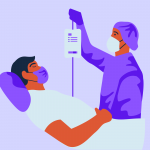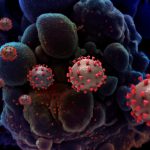COVID-19 Literature Situation Report
COVID-19 Literature Situation Report is a daily (M-F) newsletter that provides a succinct summary of the latest scientific literature related to the COVID-19 pandemic.
The scientific literature on COVID-19 is rapidly evolving and these articles were selected for review based on their relevance to Washington State decision making around COVID-19 response efforts. Included in these Lit Reps are some manuscripts that have been made available online as pre-prints but have not yet undergone peer review. Please be aware of this when reviewing articles included in the Lit Reps.
Click the SUBSCRIBE button in the right-hand column to subscribe to daily reports delivered to your inbox.
April 19, 2021
COVID-19 Literature Situation Report April 19, 2021

Few kidney transplant recipients (n = 51/136) who had been fully vaccinated with the Pfizer-BioNTech vaccine developed an antibody response to the SARS-CoV-2 spike protein, suggesting that this population may remain at risk of infection despite vaccination.
April 16, 2021
COVID-19 Literature Situation Report April 16, 2021

An estimated 545,600 to 660,200 excess deaths occurred in the US between January 2020 and February 2021, of which 75% to 88% were directly associated with COVID-19.
April 15, 2021
COVID-19 Literature Situation Report April 15, 2021

Text messages sent to COVID-19 vaccine-eligible patients increased appointment and vaccination rates by 86% and 26%, respectively, in a large, randomized trial (n > 110,000). A follow-up trial among patients who had not made first-dose appointments 8 days after the first trial (n > 90,000) repeating the intervention increased appointment and vaccination rates by 52% and 16%, respectively.
April 14, 2021
COVID-19 Literature Situation Report April 14, 2021

Adults with COVID-19 who were not hospitalized and who received the monoclonal antibody bamlanivimab had a significantly lower 30-day hospitalization rate than those who did not receive the treatment.
April 13, 2021
COVID-19 Literature Situation Report April 13, 2021

Prior SARS-CoV-2 infection was associated with an 84% lower risk of infection according to the SIREN Study, a large cohort study of over 25,000 individuals. From June to December 2020, reinfections/infections were detected in 0.02% (155 of 8,278) of participants positive at baseline compared to 0.1% (1,704 of 17,383) of participants negative at baseline. The authors found no evidence that the emergence of the B.1.1.7 variant was linked to increased reinfection rates.
April 12, 2021
COVID-19 Literature Situation Report April 12, 2021

Emergency department visits for COVID-19 were 1.7 times higher among Hispanic and American Indian or Alaska Native persons and 1.4 times higher among Black persons, than white persons between October-December 2020, based on data from 13 US states.
April 9, 2021
COVID-19 Literature Situation Report April 9, 2021

Among healthcare workers in Great Britain, one dose of the Pfizer-BioNTech COVID-19 vaccine resulted in a 4-fold reduction in asymptomatic SARS-CoV-2 infection ≥12 days post-vaccination (from 0.8% to 0.2%).
April 8, 2021
COVID-19 Literature Situation Report April 8, 2021

A single dose of the Pfizer-BioNTech vaccine substantially increased neutralizing activity against SARS-CoV-2 variants B.1.1.7, B.1.351, and P.1 among 6 previously infected healthcare workers. Geometric mean titers against B.1.351 increased by 228-fold.
April 7, 2021
COVID-19 Literature Situation Report April 7, 2021

Antibody activity elicited by the Moderna vaccine remained high 6 months after the second dose in all participants in the initial phase 1 trial.
April 6, 2021
COVID-19 Literature Situation Report April 6, 2021

An estimated 37,300 children aged 0-17 years in the US had lost at least 1 parent due to COVID-19 by February 2021, according to demographic simulations using kinship networks. Roughly 3 in 4 children who are estimated to have lost a parent are adolescents aged 10-17 years, and Black children were disproportionately affected.
Previous page Next page